How much time do you spend preparing meat? The butcher knife that has great sharp edges will cut the meat without wasting much time. The blades of the butcher knives are usually curved and long so that it can cover maximum area. The best butcher knives provide a solid grip on the handle and have dents on the edges to release meat easily.
As the blades come in various design curves, straight with pointy edges, it can be hard to decide which knife to pick. In our article, we mentioned a classic butcher knife if you are not comfortable in using modern designs. Butcher knives are comparatively heavier than all other kitchen knives as they cut through bones and joints, so you need to be careful while using one. Read the instructions thoroughly about cleaning before buying the knives, to use them for a long time.
Best Pick
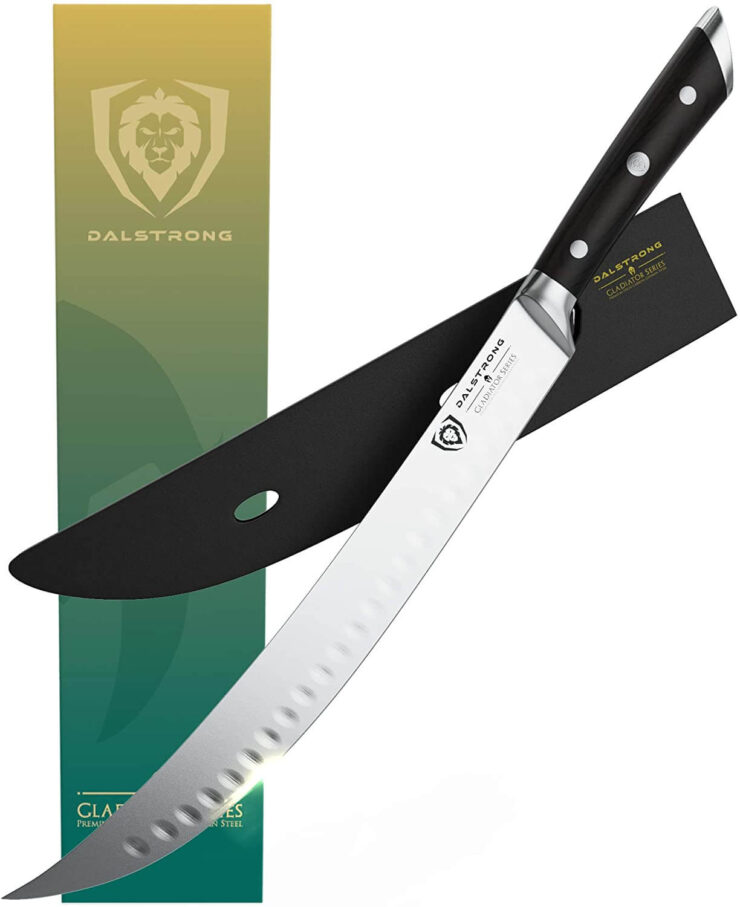
The DALSTRONG Butcher's Breaking Cimitar Knife -The Reaper Knife is our best pick on our list as it has dents on the edges to release meat without sticking. Full tang blade creates a perfect balance between the blade and handle. The German steel is forged to construct the knife and the edges are hand sharpened at 14 to 16 degrees on each side. The ergonomic handle is made from Pakkawood that offers a compatible grip and resists water.
Budget Pick
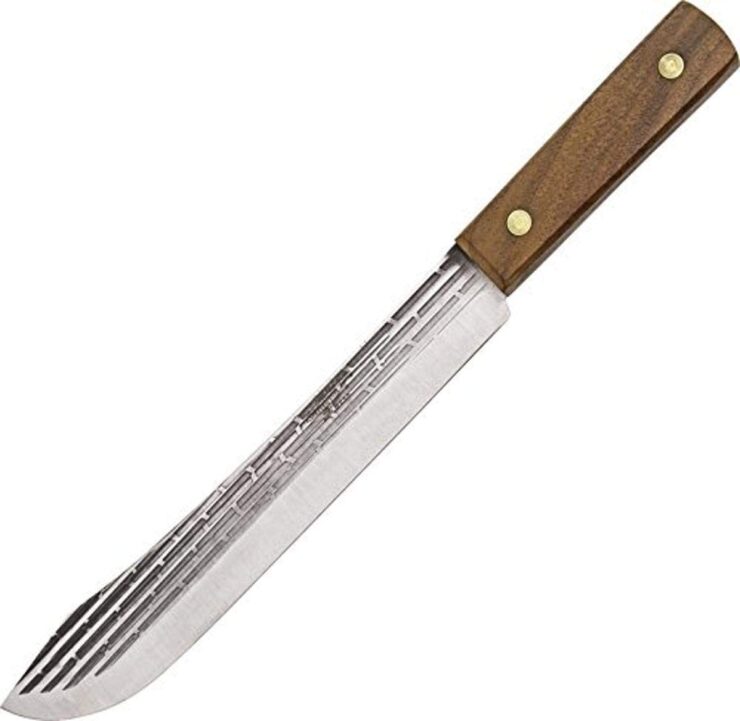
Ontario Butcher Knife is on our budget pick because of its razor-sharp edges and toughness of the knife. The ergonomic handle is made of wood to give a dry grip as wood will absorb the moisture from your hand. High carbon content and full tang of the blade ensure strength and balance while separating bones from joints.
Quick Comparison: Top 10 Best Butcher Knives
1. DALSTRONG Butcher's Breaking Cimitar Knife

Highlighted Features
Wondering for a professional butcher knife? This 14-inch knife from DALSTRONG can be the one for its remarkable strength and sharpness. This knife belongs to the gladiator series that can cut through any thick meat like beef, pork, etc. The blade is curved with dents on the edges to cut and release the meats easily.
It is a heavy-duty blade made from German steel that provides sturdiness to the knife. The weight of the knife is precise enough to hold steady while splitting the bones. As the steel is forged into a knife shape, it is a full tang knife that guarantees the durability of the blade.
The edges are sharpened at an angle of 14 to 16 degrees on each side that can pass 56+ Rockwell. Chromium is added to resist stain and rust. The tang is tri-riveted to the ergonomic handle. G10 Garolite does not penetrate water and protects the handle. However, it would be easy to control the knife if the handle had more length.
2. Ontario Butcher Knife

Highlighted Features
This old Hickory knife from Ontario has sharp edges like a razor to cut meat into perfect slices. The sharp-edged blade is made of high carbon steel that makes it strong enough to endure pressure. The blade has gone through heat treatment to increase the durability and toughness.
Another great feature about this knife is that it has full tang metal which is riveted on the handle. So, when you are using this knife on a heavy-duty task, the whole blade will support you without breaking apart.
However, the knife is not allowed to put in the dishwasher or soak in the water. One of the reasons is the wooden handle can get damaged from wetness. Besides, the blade material has a great amount of carbon but not chromium to protect from rust or corrosion. The brand advises using a wet sponge to clean the knife and then wipe it dry immediately. Also, the knife does not have bolsters to prevent slipping off from your grip.
3. Victorinox Fibrox Pro Butcher Knife
Highlighted Features
Cutting and easy release of meat is the best feature of this knife. The blade has dents on the edges that do not stick meat. The blade is designed uniquely in a cone shape to decrease friction while slicing. We like the knife for its light-weight feature. The knife is easy to twist around the delicate areas to separate the meat.
This knife is constructed from high carbon stainless steel and also went through cold treatment to give a long-lasting surface. The carbon and chromium on the blade material protect from rust and gives the strength to endure pressure.
The dimension of the blade varies from 8 to 12 inches. The handle is ergonomically designed which helps you to get a firm grip and resists sliding off. Additionally, the handle has bolsters at the front and end to protect your fingers during a heavy task. They are easy to clean as the blade does not stick meat. The knife is suitable to put on the dishwasher but it might damage other cookware with its sharp edges.
4. Ergo Chef Prodigy Series Butcher's Knife
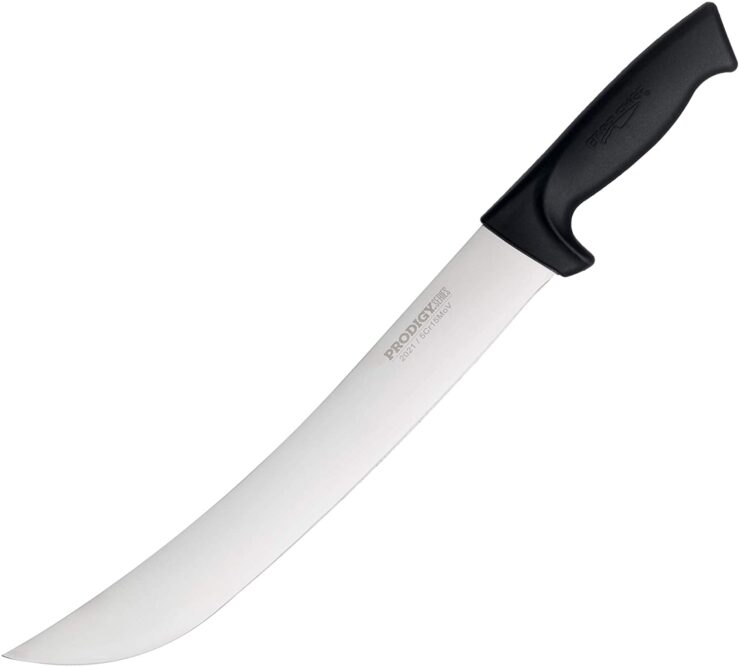
Highlighted Features
The knife with a curved blade helps to run through meat easily without requiring much friction. The knife from Ergo Chef constructs a butcher knife with stainless steel. They do not rust easily due to the presence of chromium on the alloy.
It is a 12-inch blade that covers a lot of area of the poultry and reduces the time for preparing meat. The stainless steel is forged to develop a full tang blade. As a result, the blade is durable and will not break apart if force is applied to separate the bones. Moreover, the blade is sharpened at an 18-degree angle to perfectly slice the meat.
Another feature about this knife is that the handle is designed to get a solid grip. The curve on the handle is visible which helps to comfortably place your fingers. The finger guard resists sliding off while performing heavy tasks. However, the stainless steel blade needs to sharpen quite often and can bend after a few usages. The brand recommends hand washing the knife to make it durable.
5. UltraSource - 449413 Butcher Knife
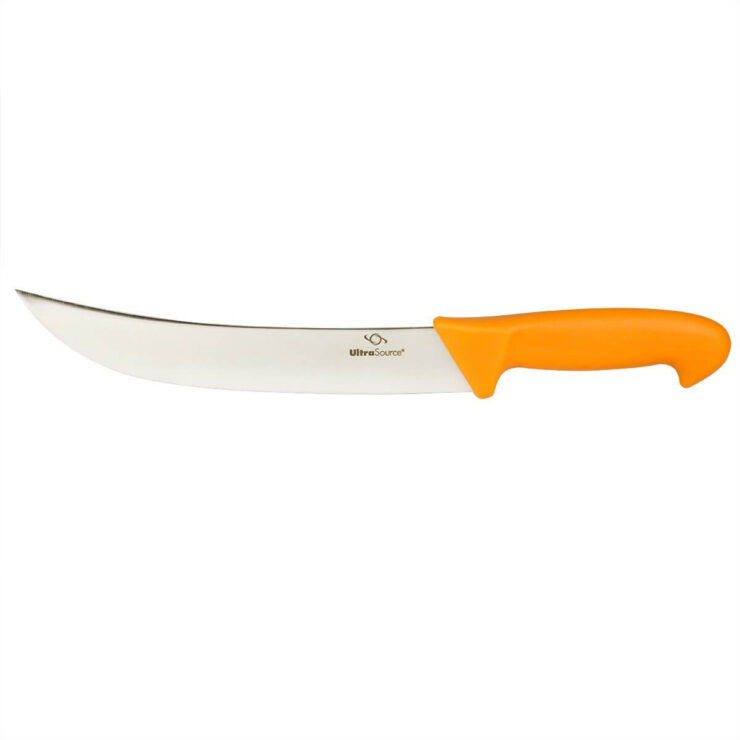
Highlighted Features
This knife has an orange color handle which helps to distinguish it from other kitchen knives. Not only the color is eye-catching, but the handle also has a bolster to hold your grip steady. NSF certified the knife for its antibacterial texture.
It is a full tang knife that will not break down even after applying much pressure. The blade is forged from molybdenum steel that resists corrosion and increases toughness. As it is a seamless blade, you can easily control the knife while splitting bones.
Another feature is that the blade is curved that covers a large area and gives a deeper cut. The blade is stiff so you will have full control over the knife. The blades need to have sharp edges to perfectly cut the meat and to retain sharpness, always hand wash the knives. Clash with other cookware can damage the edges.
6. Rada Cutlery Old Fashioned Butcher Knife
Highlighted Features
The butcher knives are designed differently for various purposes but if you want a classic butcher knife, Rada Cutlery has them. The blade is dually serrated which gives clean cuts for meat, fish, and vegetables. The knife is made from T420 high carbon stainless steel, which is usually used for making surgical tools. It resists rust due to the presence of chromium and carbon provides strength to the knife.
The blade is hand sharpened to retain the sharpness for a long time. The straight edge blade of the knife is great to slice a uniform slice of meat. A finger guard on the handle provides maximum protection while doing heavy-duty work. Moreover, the ergonomic resin made handle is safe to put on the dishwasher.
Though the knife is designed in old fashioned style, it works great with its sharp edges. The knife does not come with any sheath to safely store the knife. Though the knife can be used on the dishwasher, it can damage other cooking tools with its edges. Also, the handle is smaller compared to the blade which sometimes gets hard to control.
7. Dexter-Russell S112-8PCP Butcher Knife
Highlighted Features
The knife from Dexter-Russell has a unique design and stamped forged using high carbon and stainless steel. The feature we like about this knife is the blade construction. The blade is set up using some geometry that has some curvy and pointy edges toward the tip. You can use this knife for not only curving meats and bones but also slicing roasts and steak.
The whole knife is a great combination of silver and white color. It has a partial tang which is sealed so that water, blood, or any liquid do not enter. Bolster protects the grip from moving while dealing with a big chunk of meat. Also, the knife is NSF certified so the handle is sanitary safe to use.
However, there is no mention of the knife being dishwasher safe. So, it is better to hand wash it. It also does not come with a sheath to store the knife. Due to stamp forged, the knife is flexible to bend slightly. But there is a possibility that the blade can break if force is applied. Also, keep the knife away from flames as Polypropylene can melt in excess heat.
8. Smith Chu Butcher Knives
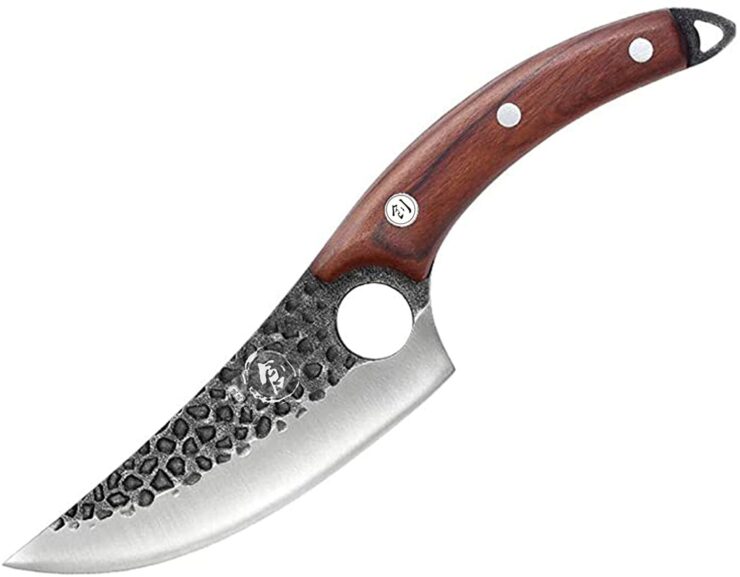
Highlighted Features
This butcher knife from Smith Chu has a very classic Japanese design that makes the blade sharp and durable. The feature we liked most about this knife is that it has a hollow space on the blade that gives a strong grip. You will not have the fear of slipping with this knife for its bolster.
It is a full tang as the triple rivets are visible on the handle. The wooden handle is slightly curved which makes holding the knife easier. The blade is made by forging carbon and manganese steel. Carbon on the blade helps to maintain sharp edges but lack of chromium does not make it free from rust.
The knife has a very unique design and can be used for multi-purpose. But it can be hard to maintain the knife. It is a heavy-duty butcher knife that comes with a sheath. As it is an ancient designed knife, it can be hard to control the knife while using it for the first time.
9. Purple Dragon Butcher Knife
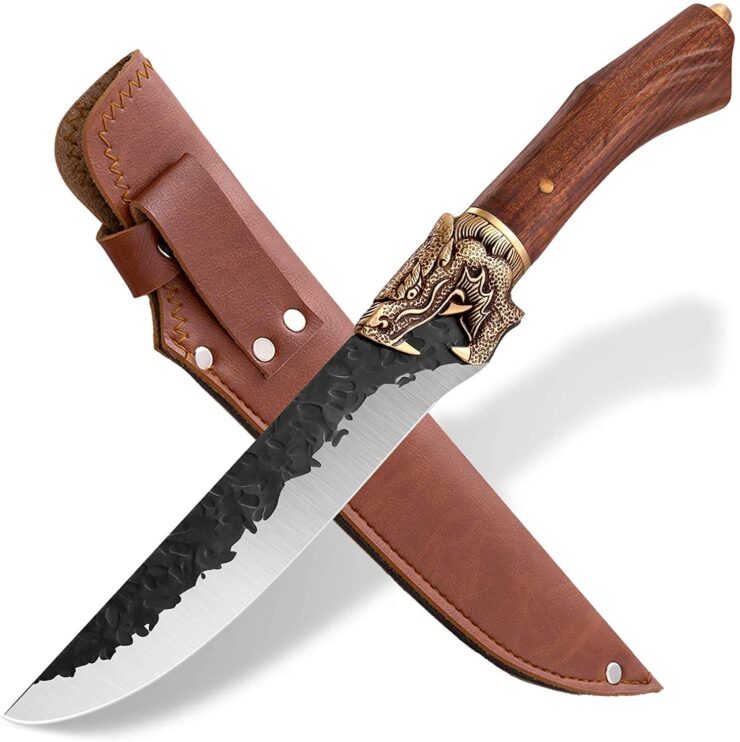
Highlighted Features
The knife from Purple Dragon is a light-weight tool that is suitable to use indoors and outdoors. This straight-edged knife is made from high carbon steel and high manganese steel. Carbon ensures the strength of the blade. The hardness of the knife is 60-62 Hardness Rockwell C which is higher than the usual knives.
The knife has a great outlook and comes with a leather sheath to safely store it. Another great feature of this knife is that the edges are sharp as a razor. The sharpness is gained by hand polishing at 16 degrees on the sides of the knife.
The full tang is riveted with brass nails on the wooden handle. This versatile knife can be used for boning, barbeque, skinning, and other outdoor activities. But as the handle is wooden and the blade has no chromium, the knife needs to be dried immediately after cleaning. Soaking the knife in water can cause rust and damage to the wood of the handle.
10. Pro Series JERO Butcher Knife
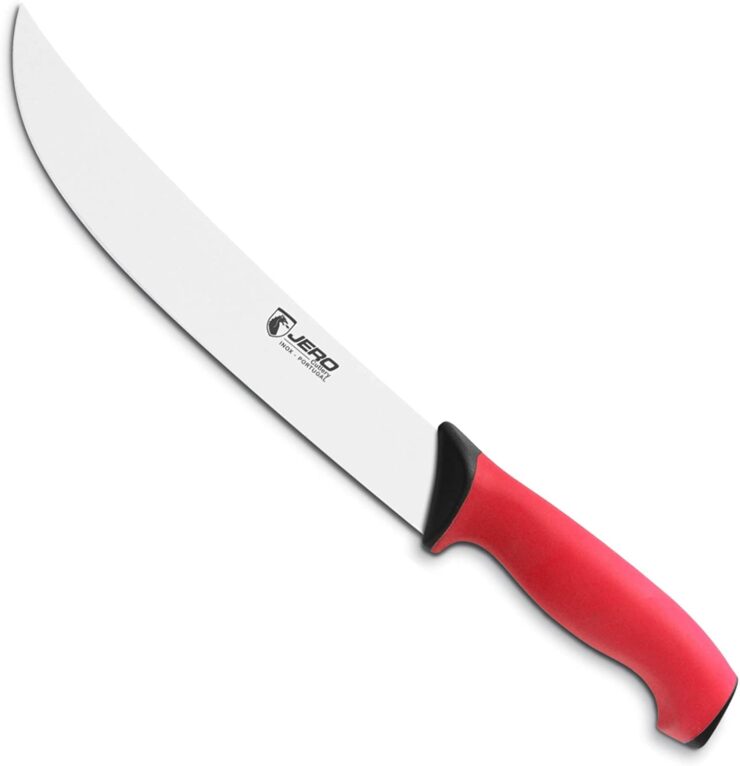
Highlighted Features
This last knife on our list is designed for processing meat with its straight edges blade. The blade edge is curved stiff that releases meat from any corners of bone. The knife is protected from rust as it is made from high carbon stainless steel.
The ergonomic handle is in red color which helps to find the knife easily. The handle provides a finger guard for safety and is made of rubber to give a compatible grip. However, rubber can melt if it comes in close contact with flame.
The sharpness of the blade will stay for a long time so they do not require frequent honing. Also, the knife is very light and can be portable for outdoor picnics.
Things to consider before buying the best butcher knives
Are you using the appropriate knife to split the joints? If you are not using the correct knife, it can take a lot of time and energy in preparing the meat. Butcher knives have sharp edges and heavy in weight. Not only the edges look different, but the butcher blades are also constructed in two different ways. Prepare a checklist before a butcher knife for your kitchen.
Edges of blades
The blades of knives come in various shapes and each shape works in different ways. Straight or curved blade, whichever you prefer, edges give different cuts in shaping the meat.
The serrated edged blade has saw-like teeth which are good for slice cuts. Besides, serrated blades do not require much honing compared to other blades.
The scalloped edged blade creates undamaged slices of meat rather than an un-uniform shape. A repeated design pattern is seen in this type of blade.
A Granton edged blade has small oval-shaped indents or dimples close to edges that help to decrease the friction while cutting the meat. They are also good for cutting thin and uniform shaped slices.
The plain edged blade is widely used in every household to cut fruits, vegetables, and meat. This edged blade is mostly used because they provide a cleaner cut and easy to control while cutting.
Thickness of blade
The thinner the knife blade, the easier it is to cut into thick meat. Though the thin knife blade appears to break down if too much force is put on it. Thicker blades are heavier compared to thin blades so they are not comfortable to move around with. Additionally, thin blades are simple to control to prepare uniform-sized meat.
Length of knife
The size of the butcher knives ranges between 8 to 14 inches. 5 to 6.5-inch blades are considered the ideal size of butcher blades. Depending on which area of poultry you are handling, you need a knife accordingly. Small blades are easy to handle and help release the meat from delicate regions. Whereas, large blades which are 7 to 8 inches in length help to cut a big bulk of the beef. Small blades work well for the skinning or trimming of poultry or fish.
The size of the knife is one of the major factors to consider if you are a professional cook. It is better to buy more than one butcher knife as small and large blades provide different results.
Construction of blade
There are two ways to construct the blades of the butcher knives. According to the way they are constructed, the blades are called a Forged blade or a Stamped blade.
Stamped knives are manufactured by cutting a piece of steel from a large sheet of steel. The piece of steel is then honed and undergoes various treatments to make it durable. They are light in weight and thinner than the forged blade. These knives can have full tang or partial tang but most of the time, stamped knives come in partial tang.
Moreover, this knife is easy to bend to cut constricted areas as they are flexible. The stamped knife does not finger guard on the handle to provide protection to your fingers. Also, it is hard to sharpen the knife as it can break easily due to its flexibility. They are mostly used for slicing or releasing meat from fat or bones.
Forged knives are heavy as they are made from a single piece of steel and honed to get into a perfect shape. The blades are made hard by giving them heat treatments. As a single piece of steel is shaped into a blade, they tend to be thick and have a full tang. Weight and full tang give the knife durability and steadiness while using.
Moreover, forged knives have bolsters to protect the finger from sudden incidents. The blades are not flexible to move around and release all meat from the bone. However, the rigidness of the blade helps to sharp them without warping or breaking. They are appropriate to cut bones because the blade can endure the pressure of slicing bones.
Blade material
The blades are constructed from steel but other elements incorporated with steel increase the durability and strength of the knife. The blades are usually made of stainless steel, high carbon steel, and high carbon stainless steel.
High carbon stainless steel blade serves the best among all other blade types. It is better than other alloys because it has chromium to protect from corrosion and carbon to ensure toughness in the knife. Also, they retain sharpness for a long time.
Stainless steel is also known to fight against corrosion as it contains chromium. However, it has very little amount of carbon so it might have the strength to endure a lot of pressure. The edges of the blade go blunt in a small amount of use.
The high carbon steel blade is great for heavy-duty work. They contain a greater amount of carbon compared to other alloys. Carbon makes the knife strong but the absence of chromium makes it unable to resist rust. Most importantly, this knife blade does not require sharpening frequently.
Knife Handle
The handle is a very important deciding factor while choosing the best butcher knife. A handle should provide a comfortable grip and resist your fingers from slipping off while slicing the meat. Some handles have bolsters to protect the fingers from an accident. Brands use diverse materials like wood, stainless, steel, Polypropylene, Proflex, Nylon, or plastic.
Wooden handles are mostly made of Pakka wood to make the handle water-proof. Woods absorb water that can rot easily and cannot be durable for long use. Pakka wood is more durable compared to other woods as it resists moisture and adds a warm look to the knife.
Garolite handle is very durable for its sturdiness and high water-resistant properties. They are manufactured with fiberglass and epoxy under certain temperature and pressure.
Stainless steel handles resist moisture and rust if they are made from good quality alloy. They can provide a great balance to the knife for preparing the meat. However, a steel handle can slip off easily if your hands are wet or oily.
Polypropylene or Plastic handle is light in weight and you move the knife easily without tiring your wrist. Water is not penetrable through polypropylene and greatly resists rust. These handles give a comfortable grip but you need to be careful not to use the knife near flames. The handle can melt if exposed to extreme flame.
Proflex handles come in various colors and they are very easy to clean. They are water and corrosion-resistant. You will also have a firm grip on this type of handle.
Tang
A portion of the blade that extends to the handle is known as tang. Knives have the partial tang and full tang. Partial tang ends up at a certain length of the handle. They are light-weighted as they require less quantity of steel to manufacture.
On the other hand, full-tang knives are heavy. As the blade is extended to the end of the handle, the knife is stronger. The blade is riveted to the handle to provide stability on the knife. Also, this knife provides great balance separating bones.
Weight
Butcher knives are used to separate bones from joints. As a result, they need to be strong and heavy to cut through the bones. Usually, butcher knives are heavier than other kitchen knives. Most of the butcher knives are forged from a single metal piece. Besides, to increase the strength the blades are full tang. Heavy blades tend to produce the pressure and friction which is required to split the bones into pieces.
Moreover, the weight of the blade and handle need to be compatible with each other. To put it in simple words, the handle needs to be slightly heavier than the blade to effortlessly control the blade. If the blade is heavy, it will be tough to place it in the right position and damage the shape of the meat. Always try to lift the knife to acknowledge the compatibility of the knife with your hands.
Honing and sharpness
The butcher blades are extremely sharp-edged knives. They require a lot of sharpness to split bones from joins. The blades are made of different materials and all of them do not retain sharpness for a long time. High carbon steel knives require sharpening once a year even if they are used in heavy-duty tasks.
The butcher knife edges need to be sharpened at an angle of 17 to 25 degrees for a greater experience. Check the sharpness before using the time as blunt takes a lot of time to prepare meat. A blunt knife can cause an accident as they need a lot of friction to cut the meat or bone.
Safe to use
Knives are very important in a kitchen and various types of knives are used for various tasks. Butcher knives are heavier as they cut bones so you need to be careful while using them. Ensure the grip and look for a bolster on the handle so the knife does not slide off your hand. Some brands design the handle with two bolsters, one at the front and another on the end of the handle. This helps to resist slipping off even if your hands are wet.
Maintaining and storing
You need to be careful whenever you are dealing with butcher knives. The knives are heavy and need to be stored in a place away from children’s reach. Sheaths are provided for the knives to store them safely.
Brands suggest cleaning the knives by hand. If you place the butcher knives in the dishwasher along with the cookware, the plates and the pans can be ruined due to collision. In addition, Pakka wood handles are resistant to water but frequent soaking in water can damage the texture of the wood. So do not soak knives in water, rather use a wet towel or sponge to remove the dirt. Moreover, wipe the knife dry after washing them with water and mild soap water.
FAQ
Is it necessary to have dents on the edges of the butcher knife?
Not all butcher knives have dents on the edges of the blade. Dents help to release meat without sticking and also creates less friction when cutting through thick meat.
How can I safely store the butcher knives?
Some brands provide leather sheath for safely storing the knives. If the brand does not provide sheath you can store them in a drawer or magnetic knife holder. Be sure to store in a place where children cannot reach.
Why are butcher knives advised to wash with hands?
Butcher knives are heavy and if they are put on the dishwasher with other cookware, everything can get damaged. Butcher knives have sharp edges that leave scratch marks on the pans and pots. Moreover, wooden handles will absorb the water and get damaged if kept wet for a long time.
How hard should the butcher knives be?
Usually, normal knives have 57-59 HRC. Butcher knives need to be strong and sharp to effortlessly cut through bones and thick meat. The knives in our list have a hardness ranging from 56 to 62 HRC. HRC stands for Hardness on Rockwell scale C.
Conclusion
What factor do you look for in butcher knives? We believe the material of the blade and the way of construction of the blade is an important feature that shows the strength and durability of the knife. The forged knife is better than the stamped knife because a single piece of an alloy is shaped into a hard blade that can endure the pressure required for cutting through bones and cartilages. The forged knife tends to be a full tang and this feature helps to provide stability during heavy tasks.
Comfortable grip with finger guards is also necessary on butcher knives. As the knives are heavy and it can slip off if you are not careful, it is necessary to design the knife with bolsters. Also handles need to be made of such materials that resist oil, water, and heat. We hope our article on best butcher knives will help to decide the one that will be suitable for your use.
